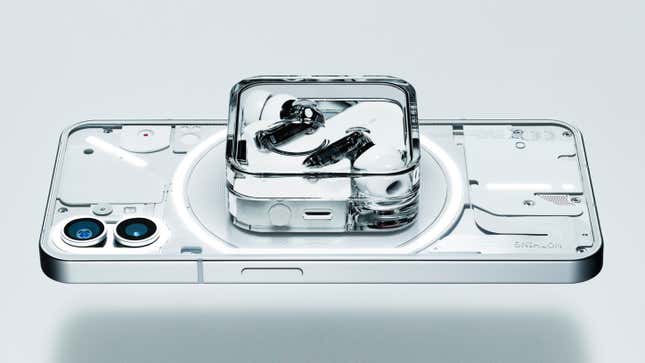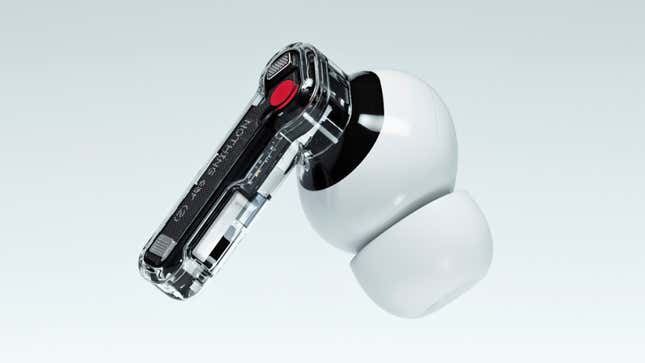Nothing Ear (2) Earbuds Will Personalize Sound With Hearing Test
No two ears are the same, and headphones that sound amazing to one user may completely disappoint another. That’s why it’s always important to try before you buy. But headphones or earbuds with customizable sound profiles allow you to tune your listening experience even after purchase. It’s an increasingly popular feature, so it makes sense that Nothing’s including it on its Ear (2) wireless earbuds.
Although Nothing is a relatively young company, it’s finally old enough to sell an updated version of one of its existing products, which in this case happens to be the company’s very first product: the Ear (1) wireless earbuds. When we reviewed them back in the Summer of 2021, we liked their unique design that also brought with it excellent sound and decent active noise cancelling performance for just $99. They weren’t the best wireless earbuds in any specific category, but as a whole, they were a very capable and affordable alternative to competitors’ products at the time.
Since their release, the Nothing Ear (1) wireless earbuds have seen a price bump to $149, and while that’s still cheaper than the $200 Google Pixel Buds Pro and the $249 Apple AirPods Pro (2nd Generation), the Ear (1)‘s performance and capabilities are starting to feel dated. That’s what the Ear (2) are here to address, boasting custom 11.6-millimeter drivers that show Nothing is now big enough not to have to settle for off-the-shelf components.
Aside from the microphones being repositioned to the outside of each earbud’s stem to help further minimize noise from wind when making calls outside, the Ear (2) aren’t a complete redesign of the Ear (1), and look quite similar to the originals. The reason to upgrade comes with how the Ear (2)‘s improved hardware is used.
G/O Media may get a commission
You really have to go out of your way to find a set of wireless headphones or earbuds that don’t offer some level of sound customization today: either through a series of EQ sliders that most users don’t really know how to adjust, or a limited selection of preset EQ settings for different genres of music. The Ear (2) offer more personalized customization, first through an Ear Tip Fit Test that ensures you’re using the proper size and fit for its silicone ear tips, and then through an actual hearing test in the Nothing X app, using the same technology as a hearing test app called Mimi.
The Ear (2)‘s hearing test simply asks users to indicate whether they can or can’t hear a series of sounds played at different frequencies—not unlike the hearing tests you might remember taking as a kid. The results are used to generate a personalized Hearing ID, which the Nothing X app then uses to adjust the Ear (2)‘s equalizer settings on the fly to compensate for external noises that may be drowning out certain frequencies, and to make whatever’s being listened to sound as good as it possibly can given that user’s hearing. It’s similar to the sound personalization technology available through the Sonarworks’ SoundID app, but more focused on what a user can and can’t hear than their musical preferences.

The Ear (1)‘s boxy charging case has been slightly updated for the Ear (2), and while it’s slightly smaller, you’ll have to look at the old and new designs side-by-side to really spot the differences. We’ve come to prefer the cylindrical charging case of the Nothing Ear (stick) earbuds, but the Ear (2) should be just as pocketable.
Battery life has been slightly boosted to 36 hours when paired with the charging case, or 6.3 hours on a single charge of the buds alone, with ANC turned off. Max out the Ear (2)‘s noise cancellation capabilities—improved through an increased sampling rate of ambient noise—and that will drop to 22.5 hours with occasional top offs in the charging case, or four hours with just the buds. Nothing has also added multi-device connectivity to the Ear (2), allowing, for example, automatic switching between a smartphone and a laptop when a call comes in. There’s also support for the hi-res LHDC 5.0 codec, with streaming data rates up to 900 kbit/s.

The Nothing Ear (2) wireless earbuds are available starting today through Nothing’s website for $149, and will be replacing the originals completely, with the Ear (stick) sticking around as a more affordable alternative. Starting on March 23, they will also be available through Nothing’s brick-and-mortar store in London, as well as a handful of Kith stores around the world. March 28 will then see an even wider international release, including availability through Stock X in the US.
No two ears are the same, and headphones that sound amazing to one user may completely disappoint another. That’s why it’s always important to try before you buy. But headphones or earbuds with customizable sound profiles allow you to tune your listening experience even after purchase. It’s an increasingly popular feature, so it makes sense that Nothing’s including it on its Ear (2) wireless earbuds.
Although Nothing is a relatively young company, it’s finally old enough to sell an updated version of one of its existing products, which in this case happens to be the company’s very first product: the Ear (1) wireless earbuds. When we reviewed them back in the Summer of 2021, we liked their unique design that also brought with it excellent sound and decent active noise cancelling performance for just $99. They weren’t the best wireless earbuds in any specific category, but as a whole, they were a very capable and affordable alternative to competitors’ products at the time.
Since their release, the Nothing Ear (1) wireless earbuds have seen a price bump to $149, and while that’s still cheaper than the $200 Google Pixel Buds Pro and the $249 Apple AirPods Pro (2nd Generation), the Ear (1)‘s performance and capabilities are starting to feel dated. That’s what the Ear (2) are here to address, boasting custom 11.6-millimeter drivers that show Nothing is now big enough not to have to settle for off-the-shelf components.

Aside from the microphones being repositioned to the outside of each earbud’s stem to help further minimize noise from wind when making calls outside, the Ear (2) aren’t a complete redesign of the Ear (1), and look quite similar to the originals. The reason to upgrade comes with how the Ear (2)‘s improved hardware is used.
G/O Media may get a commission
You really have to go out of your way to find a set of wireless headphones or earbuds that don’t offer some level of sound customization today: either through a series of EQ sliders that most users don’t really know how to adjust, or a limited selection of preset EQ settings for different genres of music. The Ear (2) offer more personalized customization, first through an Ear Tip Fit Test that ensures you’re using the proper size and fit for its silicone ear tips, and then through an actual hearing test in the Nothing X app, using the same technology as a hearing test app called Mimi.
The Ear (2)‘s hearing test simply asks users to indicate whether they can or can’t hear a series of sounds played at different frequencies—not unlike the hearing tests you might remember taking as a kid. The results are used to generate a personalized Hearing ID, which the Nothing X app then uses to adjust the Ear (2)‘s equalizer settings on the fly to compensate for external noises that may be drowning out certain frequencies, and to make whatever’s being listened to sound as good as it possibly can given that user’s hearing. It’s similar to the sound personalization technology available through the Sonarworks’ SoundID app, but more focused on what a user can and can’t hear than their musical preferences.

The Ear (1)‘s boxy charging case has been slightly updated for the Ear (2), and while it’s slightly smaller, you’ll have to look at the old and new designs side-by-side to really spot the differences. We’ve come to prefer the cylindrical charging case of the Nothing Ear (stick) earbuds, but the Ear (2) should be just as pocketable.
Battery life has been slightly boosted to 36 hours when paired with the charging case, or 6.3 hours on a single charge of the buds alone, with ANC turned off. Max out the Ear (2)‘s noise cancellation capabilities—improved through an increased sampling rate of ambient noise—and that will drop to 22.5 hours with occasional top offs in the charging case, or four hours with just the buds. Nothing has also added multi-device connectivity to the Ear (2), allowing, for example, automatic switching between a smartphone and a laptop when a call comes in. There’s also support for the hi-res LHDC 5.0 codec, with streaming data rates up to 900 kbit/s.

The Nothing Ear (2) wireless earbuds are available starting today through Nothing’s website for $149, and will be replacing the originals completely, with the Ear (stick) sticking around as a more affordable alternative. Starting on March 23, they will also be available through Nothing’s brick-and-mortar store in London, as well as a handful of Kith stores around the world. March 28 will then see an even wider international release, including availability through Stock X in the US.
